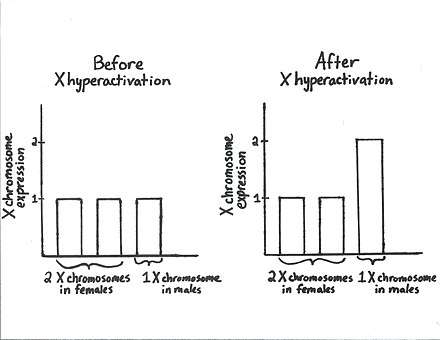X hyperactivation

X hyperactivation refers to the process in Drosophila by which genes on the X chromosome in male flies become twice as active as genes on the X chromosome in female flies.
Because male flies have a single X chromosome and female flies have two X chromosomes, the higher level of activation in males ensures that X chromosome genes are overall expressed at the same level in males and females. X hyperactivation is one mechanism of dosage compensation, whereby organisms that use genetic sex determination systems balance the gene dosage from the sex chromosomes between males and females.[1] X hyperactivation is regulated by the alternative splicing of a gene called sex-lethal. The gene was named sex-lethal due to its mutant phenotype which has little to no effect on male flies but results in the death of females due to X hyperactivation of the two X chromosomes. In female Drosophila, the sex-lethal protein causes the female-specific splicing of the sex-lethalgene to produce more of the sex-lethal protein. This produces a positive feedback loop as the sex-lethal protein splices the sex-lethal gene to produce more of the sex-lethal protein. In male Drosophila, there isn’t enough sex-lethal to activate the female-specific splicing of the sex-lethal gene, and it goes through the "default" splicing. This means that section of the gene that is spliced out in females remains in males. This portion contains an early stop codon resulting in no protein being made from it.[2] In females, the sex-lethal protein inhibits the male-specific lethal (msl) gene complex that would normally activate X-linked genes that result in an increase in the male transcription rate. The msl gene complex was named due to the loss-of-function mutant that results in the improper increase in the male transcription rate that results in the death of males.[3] In males, the absence of the necessary amount of sex-lethal allows for the increase in the male transcription rate due to the msl gene complex no longer being inhibited. This allows the expression of the X chromosome to be "doubled," or hyperactivated, to match the amount that females have with two X chromosomes.[4]
References
- ↑ Birchler JA, Pal-Bhadra M, Bhadra U (March 2003). "Dosage dependent gene regulation and the compensation of the X chromosome in Drosophila males". Genetica. 117 (2–3): 179–90. PMID 12723697.
- ↑ Gilbert SF, Barresi MJ. Developmental biology (Eleventh ed.). Sunderland, Massachusetts. ISBN 978-1-60535-470-5. OCLC 945169933.
- ↑ Sun L, Fernandez HR, Donohue RC, Li J, Cheng J, Birchler JA (February 2013). "Male-specific lethal complex in Drosophila counteracts histone acetylation and does not mediate dosage compensation". Proceedings of the National Academy of Sciences of the United States of America. 110 (9): E808–17. doi:10.1073/pnas.1222542110. PMC 3587201. PMID 23382189.
- ↑ Gorman M, Baker BS (October 1994). "How flies make one equal two: dosage compensation in Drosophila". Trends in Genetics. 10 (10): 376–80. PMID 7985243.